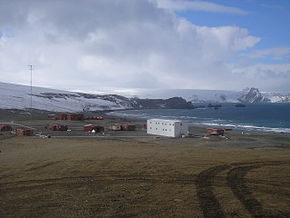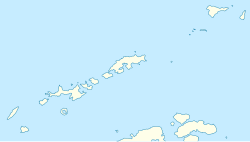Fildes Peninsula
| Fildes Peninsula | ||
 The Uruguayan base Científica Antártica Artigas on the peninsula |
||
| Geographical location | ||
|
|
||
| Coordinates | 62 ° 12 ′ 0 ″ S , 58 ° 58 ′ 0 ″ W | |
| location | King George Island , South Shetland Islands | |
| Waters 1 | Drake Street | |
| Waters 2 | Maxwell Bay | |
| Waters 3 | Fildes Strait | |
| length | 7 km | |
| surface | 29 km² | |
 Map of King George Island , with the FILDES PEN. (peninsula) in the southwest |
||
The Fildes Peninsula is a peninsula that forms the southwestern extension of King George Island in the South Shetland Islands . It has the greatest density of stations in Antarctica .
geography
The Fildes Peninsula is King George Island's largest ice-free area. It is in the northeast by the Collins glacier , the north and west through the Drake Passage , in the southeast by the Maxwell Bay and the south by the Fildes Strait limited. The latter separates them from Nelson Island, just 400 m away . The Fildes Peninsula is surrounded by a number of smaller islands, the largest of which, Ardley Island , is connected to it at low tide by the 400 m long Ardley Isthmus. Other islands are the Dart and Heidelberg Island in the south and the Whale Island and the Berlin Islands in the northwest.
The terrain of the peninsula is hilly and reaches its greatest height in the Horatio Stump at 165 m. It is covered by a dense network of running waters , the water level of which is mainly influenced by the snowmelt . There are also a large number of freshwater lakes that are only ice-free in summer. The coast consists of an alternation of steep cliffs and bays filled with rubble. In some places in the west dune formation occurs in the beach area .
geology
One of the most important fossil sites in Antarctica is located on the Fildes Peninsula . There are fossilized traces of invertebrates and vertebrates , as well as prints and grade category , as well as silicified fossils of various plant parts found on the period from the late Cretaceous to Eocene be dated. At the request of Chile, eight sites with a total area of 2.25 km² were placed under the protection of the Antarctic Treaty as a “ specially protected area of the Antarctic ” ASPA-125 .
Flora and fauna
Due to the climate, the vegetation is sparse. But there are thick cushions of moss locally. Around 175 lichen and 40 moss species are found in the region, plus some mushrooms . The two vascular plants native to West Antarctica , the Antarctic Perlwort and above all the Antarctic Schmiele , are increasingly spreading.
Seabirds are represented by twelve species that breed on the Fildes Peninsula. In addition to chinstrap , donkey and Adelie penguins , these are the giant petrel , the Cape petrel , the spotted petrel , the black-bellied sea creeper , the white-faced sheath-beak , the Dominican gull , antipodean tern , the sub-Antarctic skua and the Antarctic kua .
Five species of seals ( Weddell seals , Crabeater , Southern elephant seals , Antarctic fur seals and leopard seals ) bring mainly on the coast to the Drake Passage to their young.
The mosquito Parochlus steinenii has been detected in many lakes on the peninsula .
Research stations
On the Fildes peninsula there are five year-round manned stations with places for around 300 people. Almost half of the capacity (135) is allocated to the Chilean " Base Presidente Eduardo Frei Montalva " and the connected airport " Aeródromo Teniente Rodolfo Marsh Martin ". Further stations are the Chilean " Base Profesor Julio Escudero " (26), the Chinese " Great Wall Station " (40), the Russian " Bellingshausen Station " (38) and the Uruguayan " Base Científica Antártica Artigas " (60) . The Russian field hut “Priroda” is only visited seasonally by individual scientists.
tourism
The Fildes Peninsula is visited by several thousand tourists each year, who arrive either by cruise ship or by plane . The international association of tour operators with a destination Antarctica ( IAATO ) reports around 4,000 landings by cruise tourists for the 2015/2016 season. In addition to classic nature tourism with short visits to interesting natural areas, mountain tours and glacier hikes were carried out in the region . The Antarctica Marathon has been held annually on the Fildes Peninsula since 1995 with a limited number of participants.
Surname
The UK Antarctic Place-Names Committee named the peninsula in connection with the Fildes Strait after the British seal hunter Robert Fildes (1793-1827), who visited the South Shetland Islands in 1820/21 and 1821/22 and created the first sailing instructions for the archipelago.
literature
- Hans-Ulrich Peter, Christina Büßer, Osama Mustafa, Simone Pfeiffer: Evaluation of the degree of endangerment of the areas Fildes Peninsula and Ardley Island and development of the management plans for the designation as specially protected or managed areas (PDF; 28.5 MB). Federal Environment Agency, research report 203 13 124, UBA-FB 001155, 2008 (= texts 19/2008).
Web links
- Fildes Peninsula in the Geographic Names Information System of the United States Geological Survey (English)
- Fildes Peninsula on geographic.org (English)
Individual evidence
- ↑ Fildes Peninsula, King George Island (25 de Mayo) (PDF; 9.47 MB), Management Plan for Antarctic Specially Protected Area No. 125, accessed on July 15, 2016
- ↑ Steffen Hahn, Klaus Reinhardt: Habitat preference and reproductive traits in the Antarctic midge Parochlus steinenii (Diptera: Chironomidae) (PDF; 135 kB). In: Antarctic Science 18, 2006, pp. 175-181 (English).
- ↑ Antarctic Facilities ( Memento of November 3, 2011 in the Internet Archive ), The Council of Managers of National Antarctic Programs (English)
- ↑ Tourism Statistics on the IAATO website, accessed on July 17, 2016 (English)
- ^ Robert Fildes collection . Scott Polar Research Institute Archives, University of Cambridge, accessed February 12, 2020.
